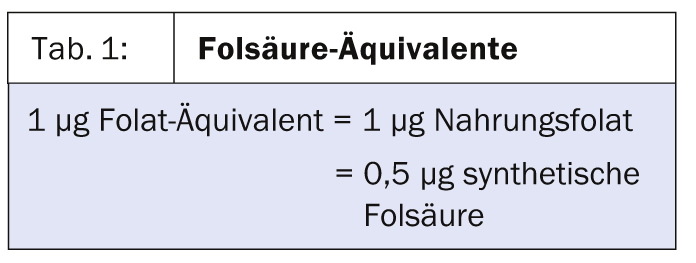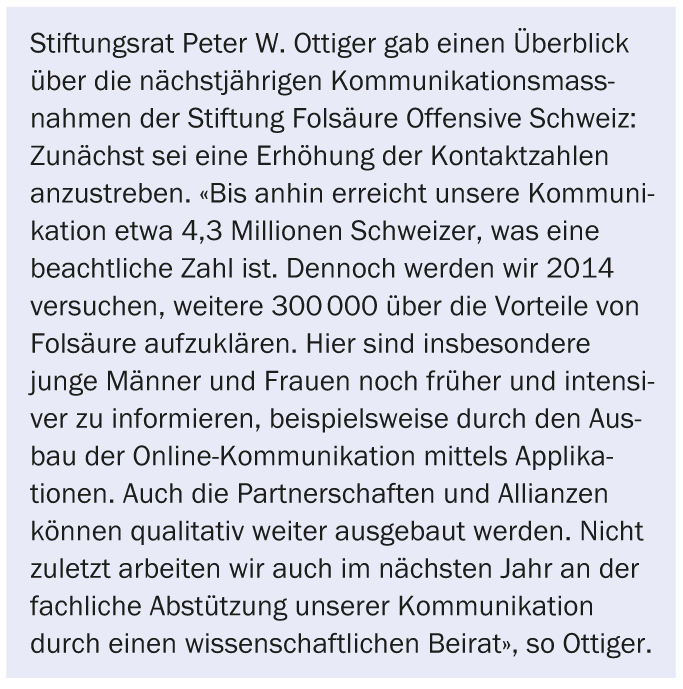At the annual meeting of the Folic Acid Offensive Switzerland, various speakers from medicine and science discussed the local supply situation and possible opportunities for improvement. In particular, the lack of Swiss survey data and the great importance of further communication and fortification measures to increase the preventive benefits of folic acid were emphasized.
Prof. Kurt Bärlocher, MD, spoke as head of the scientific advisory board. He addressed the new D.A.CH reference values and their implications for Switzerland: “Today, we usually speak of folate equivalents. This term is used to take into account the different bioavailability of folates naturally occurring in food and the synthetic folic acid from fortified foods or folic acid preparations”. (Table 1). The legally recommended daily dose of folic acid that may be added to a food is 200 µg, which is 400 µg folate equivalents. The new D.A.CH folate reference values provide for 300 µg equivalent/day. This is largely the international standard, with only the UK recommending slightly lower (200 µg) and the USA slightly higher (400 µg) reference values.

The change became necessary because the basis of the reference values has changed. Until recently, the influence of folate/folic acid on homocysteine was of particular interest, especially the regulation of homocysteine levels in the blood caused by it [1]. New data on supply have been added in certain countries, e.g. information on consumption levels from nutrition surveys. In addition, the folic acid status is nowadays determined by means of plasma and erythrocytes (Tab. 2).

Situation in Switzerland
“Unfortunately, there are practically no exact survey data from Switzerland on the amount of folate consumed and the folate status,” Prof. Bärlocher said. In Germany, on the other hand, a national consumption study was conducted in 1998 and supplemented in 2005/2006 to include folate status. In addition, a study on the nutrition of children and adolescents, called EsKiMo, has been running since 2003. In Austria, data from the 2012 Nutrition Report, in which age-dependent consumption levels and folate status were collected, show that adults between 18 and 65 years of age do not consume the recommended target value of 300 µg on average. The purely mathematically derived values from Switzerland also continue to indicate a slight undersupply.
“If one assumes that the reference values should cover the needs of 98% of a population group and that the surveys and calculations only depict mean or median values, the issue gains additional explosiveness,” noted Prof. Bärlocher.
Folic acid before and during pregnancy
Only a sufficient intake can lead to a good folate status (Tab. 2) . Here, too, there are few data from Switzerland. However, a study showed that in 2001, 4% of pregnant women still had a serum folic acid level of <6 nmol/l, which corresponds to a deficiency and is associated with risks for the unborn child. In particular, neural tube defects (NRD) such as spina bifida can be prevented with an additional administration of at least 400 µg of synthetic folic acid for women of childbearing age, at least four weeks before the start of pregnancy and during the first twelve weeks of pregnancy.
Overall, these findings can be summarized as follows, according to Prof. Bärlocher:
- The importance of folate and folic acid for health and prevention remains essential.
- Regular surveys to record consumption levels and folate status should be encouraged.
- Young women need to be informed even earlier on the subject of NRD.
- Young men still need to be better informed on the subject of semen quality.

Flour enrichment
Becky Handforth of the Flour Fortification Initiative, Belgium, underscored the risk of neonatal NRD: “It is estimated that about 300,000 NRDs occur annually worldwide. In Europe, approximately 4500 pregnancies are affected. This is all the more tragic because many of these birth disorders can be prevented by sufficient folate or folic acid supply during pregnancy.”
Since foods usually provide too little folate, supplementary measures are needed, e.g. fortification of flour, as well as supplements. “Eight regional studies from Argentina, Canada, Chile, South Africa, and the United States show a 31- to 78-percent risk reduction for NRD from wheat flour fortification. On average, this represents a 46% reduction. A study from Ireland [2] proves that the fortified products also actually led to an increase in folate status, bringing it closer to the optimal prevention level,” Handforth concluded.
Source: Annual Meeting of the Folic Acid Offensive Switzerland Foundation, September 25, 2013, Hochdorf
Literature:
- Tucker KL, et al: Folic acid fortification of the food supply. Potential benefits and risks for the elderly population. JAMA 1996; 276(23): 1879-1885.
- Hoey L, et al: Effect of a voluntary food fortification policy on folate, related B vitamin status, and homocysteine in healthy adults. Am J Clin Nutr Nov 2007; 86(5) : 1405-1413.
HAUSARZT PRAXIS 2013; 8(11): 7-8











